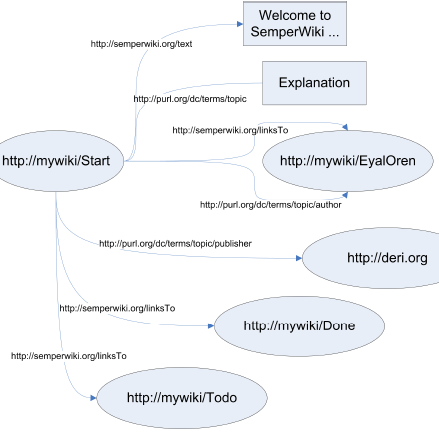TiddlyWiki, Microcontent,RDF and Notes...
The title of this post is too short, but it’s a title…
These words are connected with the content of this post, like a sort of brainstorming of the content itself:
microcontent rdf tiddlywiki sioc semperwiki notes relations aggregation
It’s not simple to explain my idea, because it’s not clear enough to me too…
So this is a sort of detailed brainstorming on the topics above…
Some words about Microcontent…
I have found some interesting links about, one is a MUST:
-> MicroContent definitions and terminology
MicroContent is an addressable structured indivisible self-contained piece of digital information.
MicroContent contrasts with Content in general thanks to the use of these adjectives:
-** Indivisible**: this implies that the piece of information, the MicroContent Item, can no longer be cut into smaller useful pieces.
Structured: MicroContent does not consist of a single blob of information, but it has structure. One can distinguish between metadata and internal structure. Metadata is information that pertains to the publication of an MicroContent item, such as the author, the publication date/time, the permalink, etc. The internal structure can be limited to a single field, which contains the actual information. However usually more Fields are used. (is there a relation with Dublin Core here?)
Addressable: MicroContent is addressable on the Internet. This implies that it has a permalink, or better an (perma)URI. The permalink is an essential part of the structure of MicroContent. The addressability of a MicroContent Item is what makes MicroContent interesting.
Note that I do not user the word small as this has become ambiguous. The word MicroContent can also apply to pieces that are in fact very large in terms of megabytes.
(3) MC is self-contained: It is a unit of information that can stand for itself not only formally (through metadata) but also semantically. It can clearly be separated from its macro-context. It is not locked into a macro-text or – important for Web 2.0 – into an application. It is focused around a single idea or small set of related ideas (>> meme). It is accompanied and defined by explicit or implicit metadata.
(4) MC is reusable and remixable: It is content set free to separate and form new patterns, in the mind of the user, on the screen of a device or within the processing logic of an application. It is “small pieces loosely joined”, enabling new technologies of aggregation and syndication and new sociocultural practices (> Web 2.0, social software). It allows new “fuzzy” forms of texts, new open patterns of sign, new collaborative practices of communication and semiosis.
Now that MicroContent is clearer, let’s look to another interesting post:
-> Three dimensions of MicroContent
Microcontent and Tiddlywiki
This is an example of useful taking notes tool that is based upon the concept of Tiddler, a sort of container of information related and connected to others but also indipendent, a microcontent…
The data is saved in div blocks using html attributes to make metadata about the tiddler and so about the content itself
As i have written some times ago its power is portability and non-linear written capacity, like a small hypertext in one page that always changes…
Thinking on it using RDF it’s natural and a better solution for unthinking uses…
Microcontent and SEMPERwiki
Let me show you something else…
I have tried SEMPERwiki, a sort of RDF-based Tomboy note taker under GNOME…
I think it has two elements very interesting IMHO:
- based on RDF, it contains Redland backend to save data…
The data is modelled based up on this schema page example:

And this small ontology:

the sidebar and the way that RDF data can help track and get useful info…
Dynamic Sidebar The links on the sidebar are generated automatically based on the available semantic information in the system.
We show sets of pages that are related to the current one, and order these relations by the size of the sets of related pages.
We show the most specific pages first (the smallest set of related pages), and gracefully decrease the amount of correspondence until we show all pages.
My idea of Microcontent ontology
The basic idea is an evolution of TiddlyWiki design, based on RDF of course!!
And not only: merging the power of non linear notes of TiddlyWiki and some ideas from SEMPERwiki… plus a semi-graphical approach.. [ thinking on a GUI similar to TinderBox for Mac ]
For now, we can think of a sort microcontent model like SEMPERwiki one, but more detailed.
What i like of RDF is its power of saying something and at the same time let the data open to others addons… The “Open world” point of view…
And its power to keep relations human and machine understable…
I’m thinking about a sort of a sematic tiddler rappresentation… based on this ontology:

It’s the SEMPERwiki ontology applied not to a page, but to a tiddler thinking on TiddlyWiki…
And where we can use dc:source for internal links reference, dc:author for the author, dc:subject for the main topics and so on…
Using a model of data that it’s open and forever in “working progress” as our mind and our notes…
There is a lot of potential in my opinion…
Some doubts…
There are some things that i’m not conviced…let me show you…
- how saving formatting text, probably in the same way as RSS feeds are saved in the content-encoded tag… The SEMPERwiki example how works with this problem?
- RDF literals can be used as semantic container of a microcontent note?
- work in progress
Some others stuff
Very good points of view in the question from Danny Ayers in these two posts:
-> Overwhelmed (by buzzwords)
-> Bosworth’s Web of Data
But what the Tiddly has that wouldn’t be immediately available in the blog data is a plethora of useful hyperlinks - the Wiki words. Ok, bring in folksonomy tags. It would be nicest to use a full-blown SKOS based model, but dc:subject with each keyword might do for starters.
So let’s say I’ve got this RDF store containing project stuff, blog stuff, FOAF stuff, calendar stuff. Going quite a way beyond microcontent, call it hyperdata. It’s interfaced via a Tiddly kind of thing, with a handful of different views and some user-choosable filter/ordering things - reverse chronological is not the only fruit. Taxo and other trees, graph-shaped visualizations might be useful. Could also add a bit of machine-inferred metadata, along the lines of CAPS and SIPS. Oh yeah, and put an Atom feed somewhere…
I reckon this could be a good approach to a personal knowledgebase, rather than using a fat desktop or thin browser client with big data on the server, use a browser with a middleweight app with a good slice of the graph pulled locally with Ajax, accessible through different views. I don’t know how far browsers on mobile devices have got, but assuming they could handle the JS then this approach could be marvellous for intermitently-connected work. (Yep, sync needs some thought, along with the idea of working against multiple stores).
Using an RDF store makes the data mixing feasible and meshes nicely with the URI-linking of the Web. But this is still only scratching the surface of the potential - the personal knowledgebase would just be a cached bit of the Semantic Web, transparent interwiring between this and other bits could really fire off in a dimension that the current Web can’t.
Thinking on having a similar tool on small devices, what about the Nokia 770 [some posts in italian ]? It’s a starter…
Let me know what you think…
Other ideas in the next weeks…
Work in progress…
